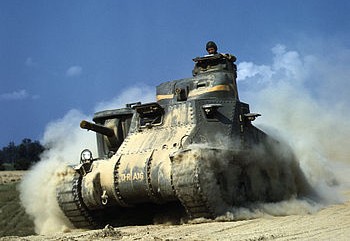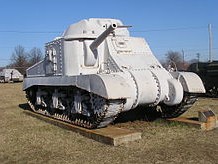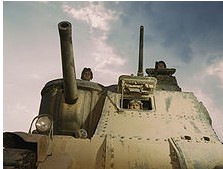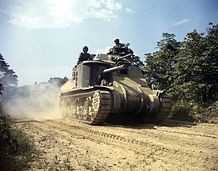
M3 Lee
Wikipedia | 2012-10-16 17:48

| Medium/Light Tank M3 GRANT | |
|
Medium Tank M3, Fort Knox, June 1942 |
|
| Type | Medium/Light tank |
| Place of origin |
|
| Service history | |
| Used by |
|
| Wars | World War II |
| Production history | |
| Produced | August 1941–December 1942 |
| Number built | 6,258 |
| Variants | numerous, see text |
| Specifications | |
| Weight | 30 short tons (27 t) |
| Length | 18 ft 6 in (5.64 m) |
| Width | 8 ft 11 in (2.72 m) |
| Height | 10 ft 3 in (3.12 m) - Lee |
| Crew | 7 (Lee) or 6 (Grant) |
|
|
|
| Armor | 51 mm |
|
Main armament |
1 × 75 mm Gun M2/M3 in hull 46 rounds 1 × 37mm Gun M5/M6 in turret 178 rounds |
|
Secondary armament |
2-3–4 × .30-06 Browning M1919A4 machine guns 9,200 rounds |
| Engine |
Wright (Continental) R975 EC2 400 hp (300 kW)/340 hp (250 kW) |
| Transmission | Synchromesh, 5 speeds forward, 1 reverse |
| Suspension | vertical volute spring |
| Ground clearance | 18 in (0.46 m) |
| Fuel capacity | 662 liters (175 US gallons) |
|
Operational range |
193 km (119 mi) |
| Speed |
26 mph (42 km/h) (road) 16 mph (26 km/h) (off-road) |
|
Steering system |
Controlled differential |
The Medium Tank M3 was an American tank used during World War II. In Britain the tank was called by two names based on the turret configuration. Tanks employing US pattern turrets were called the "General Lee", named after Confederate General Robert E. Lee. Variants using British pattern turrets were known as "General Grant", named after U.S. General Ulysses S. Grant.
Design commenced in July 1940, and the first M3s were operational in late 1941.[1] The U.S. Army needed a good tank and coupled with United Kingdom's demand for 3,650 medium tanks immediately,[2] the Lee began production by late 1940. The M3 was well armed and armored for the period, but due to design flaws (high silhouette, archaic sponson mounting of the main gun, below-average off-road performance) it was not satisfactory and was withdrawn from front line duty as soon as the M4 Sherman became available in large numbers.
History
In 1939, the U.S. Army possessed approximately 400 tanks, mostly M2 Light Tanks, with less than a hundred of the discontinued M2 Medium Tanks.[3] The U.S. funded tank development poorly during the interwar years, and had no infrastructure for production, little experience in design, and poor doctrine to guide design efforts.

M3 Grant at the US Army Ordnance Museum
The M2 series medium tank was typical of armored fighting vehicles (AFVs) many nations produced in 1939. When the U.S. entered the war, the M2 design was obsolete with a 37 mm gun, 32 mm frontal armor, machine gun secondary armament and a very high silhouette. The Panzer III and Panzer IV's success in the French campaign led the U.S. Army to immediately order a new medium tank armed with a 75 mm gun in a turret. This would be the M4 Sherman. However, until the Sherman was in production, an interim design with a 75 mm gun was urgently needed.
The M3 was the solution. The design was unusual because the main weapon — a larger caliber, low-velocity 75 mm gun — was in an offset sponson mounted in the hull with limited traverse. A small turret with a lighter, high-velocity 37 mm gun sat on the tall hull. A small cupola on top of the turret held a machine gun. The use of two main guns was seen on the French Char B, the Soviet T-35, and the Mark I version of the British Churchill tank. In each case, two weapons were mounted to give the tanks adequate capability in firing both anti-personnel high explosive ammunition and armor-piercing ammunition for anti-tank combat. The M3 differed slightly from this pattern having a main gun which could fire an armor-piercing projectile at a velocity high enough for efficiently piercing armor, as well as deliver a high-explosive shell that was large enough to be effective. Using a hull mounted gun, the M3 design was produced quicker than if a turret mounted gun design had been manufactured. It was understood that the M
3 design was flawed, but Britain[4] urgently needed tanks.
The M3 was tall and roomy: the power transmission ran through the crew compartment under the turret cage to the gearbox driving the front sprockets. Steering was by differential braking, with a turning circle of 37 ft (11 m). The vertical volute suspension units included a return roller made with self-contained and readily replaced units bolted to the chassis. The turret was power-traversed by an electro-hydraulic system — an electric motor providing the pressure for the hydraulic motor. This fully rotated the turret in 15 seconds. Control was from a spade grip on the gun. The same motor provided pressure for the gun stabilizing system.

Front view, M3
The 75-mm was operated by a gunner and a loader. Sighting the 75-mm gun used an M1 periscope — with an integral telescope — on the top of the sponson. The periscope rotated with the gun. The sight was marked from zero to 3,000 yd (2,700 m)[5] with vertical markings to aid deflection shooting at a moving target. The gunner laid the gun on target through geared handwheels for traverse and elevation.
The 37-mm was aimed through the M2 periscope, though this was mounted in the mantlet to the side of the gun. It also sighted the coaxial machine gun. Two range scales were provided: 0-1,500 yd (1,400 m) for the 37-mm and 0-1,000 yd (910 m) for the machine gun.
The British ordered the M3 when they were refused permission to have their tank designs (the Matilda infantry tank and Crusader cruiser tank) made by American factories. British experts had viewed the mock-up in 1940 and identified several flaws — the high profile, the hull mounted gun, radio down in the hull (instead of turret), smooth tracks, riveted and insufficient armour, and little attention to splash-proofing the joints.[6] The British agreed to order 1,250 M3, to be modified to their requirements - the order was subsequently increased with the expectation that when a superior tank was available it could replace part of the order. Contracts were arranged with three U.S. companies, but the total cost was approximately 240 million US dollars. This sum was all of the British funds in the US and it took the Lend-Lease act to solve the financial problems.

M3, Fort Knox, 1942
The prototype was completed in March 1941 and production models followed with the first British specification tanks in July. The British cast turret included a bustle at the back for the Wireless Set No. 19 radio. It had thicker armour than the U.S. one and removed the U.S. cupola for a simple hatch. Both U.S. and British tanks had thicker armour than first planned.[7] The British design required one fewer crew member than the US version due to the radio in the turret. The U.S. eventually eliminated the full-time radio operator, assigning the task to the driver. The British realized that to meet their requirement for tanks both types would be needed.
The U.S. military used the "M" (Model) letter to designate nearly all of their equipment. When the British Army received their new M3 medium tanks from the US, confusion immediately set in,[8] as the M3 medium tank and the M3 light tank were identically named. The British army began naming[9] their American tanks, although the U.S. Army never used those terms until after the war.[10] The M3 tanks with the new turret and radio setup received the name "General Grant", while the original M3s were called "General Lee", or more usually just "Grant" and "Lee". The M3 brought much-needed firepower to British forces in the African desert campaign.
The chassis and running gear of the M3 design was adapted by the Canadians for their Ram tank. The hull of the M3 was also used for self-propelled artillery and recovery vehicles.
Combat performance

Crew of M3 tank at Souk el Arba, Tunisia, November 23, 1942
European and Mediterranean Theaters
Of the 6,258 M3s produced by the U.S., 2,855 M3s were supplied to the British Army, and about 1,386 to the Soviet Union.[11] Consequently, one of the American M3 medium tank's first actions during the war was in 1942, during the North African Campaign.[12] British Lees and Grants were in action against Rommel's forces at the disastrous Battle of Gazala on 27 May that year. They continued to serve in North Africa until the end of that campaign. A regiment of M3 Mediums was also used by the U.S. 1st Armored Division in North Africa. In the North African campaign, the M3 was generally appreciated for its mechanical reliability,[13] good armor and heavy firepower.
In all three areas, it was able to fight German tanks and towed anti-tank guns. The tall silhouette and low, hull-mounted 75-mm were severe tactical drawbacks, since they prevented the tank from fighting from hull-down firing positions. The use of riveted armor led to a problem called "spalling," whereby the impact of enemy shells would cause the rivets to break off and become projectiles inside the tank. Later models were welded to eliminate this problem. The M3 was replaced by the M4 Sherman as soon as these were available, though several M3s saw limited action in the battle for Normandy as armored recovery vehicles with dummy guns.
Over 1,300 diesel-engined M3A3 and M3A5s were supplied to the USSR via Lend-Lease in 1942-1943. All were the Lee variants, although they are sometimes referred to generically as Grants. The M3 was unpopular in the Red Army, where its faults showed up in engagements with enemy armor and anti-tank weapons, with the Soviets bestowing it the nickname of "БМ-6 — братская могила на шестерых"[14] that could be translated as "collective grave for six people", although the official designation was "М3с" ("М3 средний", M3 medium) to distinguish them from "М3л" ("М3 лёгкий", M3 light) Stuart tanks. Few were seen in combat after about mid-1943, though some M3s were used on the Arctic Front in the Red Army's offensive on the Litsa front towards Kirkenes in October 1944. The Germans had on this front only relatively few obsolete French Hotchkiss H35 and Somua S35 tanks that they had acquired during occupation, consequently the M3's inferior tank-to-tank capabilities were of limited importance.
Pacific and China-Burma-India Theaters
The Pacific War was an ocean war fought primarily by the naval fleets of the U.S. and the Empire of Japan. Tank warfare played a secondary role as the primary battles were between warships and between infantry.[15][16] Within the Pacific Theater of Operations, the U.S. Marine Corps deployed all six of its tank battalions; the U.S. Army deployed only a third of its 70 separate tank battalions, and none of its armored divisions, in the Pacific.[17]
During the battle for Tarawa island in 1943, the U.S. Army attacked nearby Makin Island, which was considered a less costly operation. The army was supported by a platoon of M3A5 Lee medium tanks from the U.S. Army's 193rd Tank Battalion, making this battle the only U.S. Army combat use of the M3 in the Pacific Theater.[18] No M3s were supplied to the U.S. Marine Corps.
When the British received their new M4 Shermans from America, it quickly transferred approximately 1,700 M3s to the China-Burma-India (CBI) theater, deploying about 800 M3s to Australian forces and about 900 M3 tanks to Indian forces.[19] British Lees and Grants were used by the British Fourteenth Army[20] from the fall of Rangoon,[21] performing admirably[22] until the end of the war. In the Far East, the M3's main task was infantry support. It played a pivotal role during the Battle of Imphal, during which the Imperial Japanese Army's 14th Tank Regiment (consisting of mostly captured British M3 Stuart light tanks and their own Type 95 light tanks) encountered M3 medium tanks for the first time.[23] Despite their lower-than-average off-road performance, the M3s performed well as they traversed the steep hillsides around Imphal.
Declared obsolete in April 1944,[24] the General Lee fought on against Japan until the end of the war. In the end, the M3 in the CBI theater performed the mission its original designers had intended it to do: that of supporting the infantry.[25]
Share this page



















